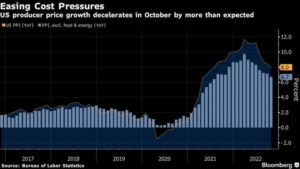Reade Pickert
BloombergNovember 15, 2022
Excluding the volatile food and energy components, the so-called core PPI was unchanged in October and rose 6.7% on an annual basis. The data come on the heels of a smaller-than-expected monthly increase in the October consumer price index, which investors and Wall Street welcomed as a sign that the fastest price increases in decades are finally be starting to ebb.
After peaking in March at 11.7% on an annual basis, producer price growth has moderated amid improving supply chains, softer demand and a weakening in many commodities prices. Excluding food and energy, costs of goods declined during the month, and services prices fell for the first time since.
The Federal Reserve, which is watching all inflation data closely, is anticipated to soon slow the pace of interest rate hikes, though officials have emphasized they remain firmly committed to taming inflation.
Read more: US Inflation Slows More Than Forecast, Gives Fed Downshift Room
Many companies have successfully passed on much, if not all, of the increases in input and labor costs to consumers, but some companies have recently indicated a hesitation to pursue further aggressive price hikes amid the uncertain economic environment.
What Companies Are Saying…
- “We’re certainly not going to try and raise prices during this time. But certainly, we’ve demonstrated, over the last 12 months or so, that we’ve got almost 6% price increases and we haven’t seen the loyalty and the transactions abate.” — Howard Schultz, CEO of Starbucks Corp.
- “By the end of the year, we will recover all raw material inflation. And before the end of the first quarter, we will cover all total inflation.” — Michael McGarry, CEO of PPG Industries Inc.
- “We continue to face elevated input cost inflation, especially in the areas of energy, transportation, packaging, wheat, dairy & edible oils. To offset these challenges, we have implemented appropriate price increases across key markets.” — Dirk Van de Put, CEO of Mondelez International Inc.
Tuesday’s report showed goods prices rose 0.6%, reflecting increases in food and energy. Services prices declined 0.1%, including decreases in trade, transportation and warehousing costs. The Labor Department said a major factor in the decline was due to a drop in fuel retailer margins.
Producer prices excluding food, energy, and trade services — which strips out the most volatile components of the index — increased 0.2% from the prior month. The measure was up 5.4% from a year ago, the smallest advance since May 2021.
Costs of processed goods for intermediate demand, which reflect prices earlier in the production pipeline, fell. Excluding food and energy, those costs slumped 0.8%, the most since the start of the pandemic.
Separate data have also pointed to an easing of cost pressures. The Institute for Supply Management gauge of prices paid for raw materials by manufacturers slipped last month to its lowest reading since May 2020. And wage growth, while still robust, has eased somewhat.

